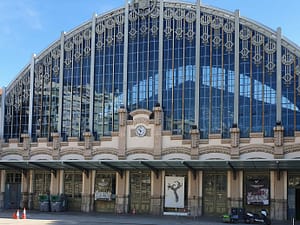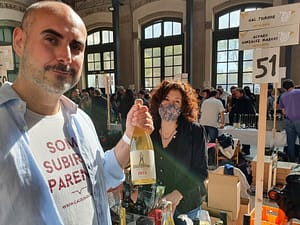I am back at Barcelona’s Vella Terra. It is now in its 6th edition after having been postponed, last time since February this year. Vella Terra is a fair organized by the couple Ale Delfino and Stefano Fraternali, and celebrates natural and low-intervention wines from smaller wineries, most of them family businesses. This year there were 146 artisans from 16 countries booked in. There were also related companies like Pulltex, distributor of wine accessories (see my company profile of one of their most important collaborators Pulltap’s in a forthcoming article) and restaurants like Garage Bar and Zaza. There were of course also various activities around town, with so much “talent” gathered in one place.
This year I had no special theme in mind. I did select a bit, but was also open to walk in new doors. So here are some of the most interesting tastes, only organized from local to global, if I can put it that way. And as many times before, I try to restrict myself by chosing only one wine from each winery. In this first part we shall deal with Spain.
I had tasted a few wines from Cal Teixidor before. (See my latest wine of the week here.) Their winery is found in Corbera de Llobregat, not far from Barcelona. At Vella Terra Josep Casañas showed an impressive range, most of the wines based on the two vineyards described in my latest wine of the week, that you can read about here). These are a north-facing xarel.lo vineyard that gives acidity and minerality, and a south or southwest-facing macabeu vineyard that gives more fruity, aromatic wines. There were also wines made from subirat parent (see his T-shirt), also known by the name malvasía riojana. Here I chose a wine solely based on the macabeu vineyard from 1974. It’s called Masía Cal Salines 2019, is made with whole clusters and aged … Dark yellow; appley, with fennel-tones; rich, structured and mouth-filling. Josep also showed a superb subirat parent traditional method sparkler with almost the same name, Masía Cal Salines Brut Nature Reserva. This fruity wine, with herbs and mature apple, but also mineral and with a fresh acidity – was of the 2017 vintage and aged 42 months on the lees. Which strictly makes it a gran reserva (it’s minimum 30 months, by Cava standards). Lastly, his wife Brugués is the force behind the estate’s own olive oil.
Loxarel I have known a long time, and I’ve appreciated their good and not least good value wines. Last time they were represented in a wine of the week post was here. In February I had an appointment with winemaker Pep for a visit to their Penedès winery, but had to cancel as I was struck by covid. Here founder Josep Medios participated together with Anna Janué, who calls herself commercial sommelier. They showed an impressive range, such as still and sparkling Loxarel à pel, an amphora-made xarel.lo, and a “xarel.lo sherry” (called Himen), and reds. Here I chose Loxarel 109 2011, a brut nature reserva (well, technically it qualifies for a gran reserva). This wine was the reason that Loxarel left DO Cava for Clàssic Penedès, because the authorities didn’t allow them to bottle without disgorging. Loxarel’s opinion is that after nine years the wine has already integrated the yeast. Obviously, this is also a xarel.lo-dominated wine, like nearly all the most ageworthy. Aged on the lees for 109 months in a shelter from the civil war. Light in colour; smells of mature apples, burnt yeast and coffee; is rich with a super acidity and mineral finish, it’s still full of vividness and not at all “old”. It comes in a bottle wrapped in paper.
Clos Lentiscus is located inside the national park in the Garraf mountains just outside Sant Pere de Ribes. The winery was established in 2001 by brothers Manel and Joan Aviñó, when they set out on a task of restoring the family vineyard from the 14th century. They currently cultivate 22 hectares of vineyards in a biodynamic way, of which 95 percent are planted with local grape varieties.
Before the fair I had warmed up with a classy, mineral red, Perill Noir Carinyena 2017, a varietal carinyena that also were shown here. I chose one of the bright sparklers that Manel’s daughter Núria poured. The Núria Parellada 2018, one of several wines named after her, is a pét-nat, very fresh for its age. It’s very dry with notes of red apples, raspberry and bright citrus.
I met Dido and Jurriaan three years ago at the Garage Bar. Then they were just starting, after having travelled the world and worked in a number of wineries. Since then I have come across their rosé sparkler Juicy several times. (See here.) share a passion: wine. They bought 9.5 hectares of vines planted in the Albera natural reserve of Alt Empordà, where they farm organically and have started to implement biodynamic principles. They have now bought an old coop in the village Rabós, where they first were hiring space.
Many of their labels carry references to music, such as Big Time Sensuality, Comfortably numb and Libertango. My pick here would be Magic Potion 2021, a cabernet franc-sauvignon pét-nat named after the album of The Black Keys: Blueish red, full of fresh and sweet strawberry and raspberry fruit, and in the mouth some structure that complements well with a slight residual sugar.
Architect Alfredo Arribas is quite new on the Catalan wine scene, having taken over the family’s vineyards in 2001 founded his bodega in 08. But he has made himself heard. His two main series are Siuralta, mostly monovarietal wines from Montsant and Instabiles, more free-spirited wines from Priorat. The vineyards are in Cornudella de Montsant, in the north of the Priorat region, and the grapes are vinified in the winery in Falset. Arribas’ project is a response to the challenges of climatic change, seeking higher altitude vineyards, more shade and rainfall, biodiversity and more.
For Siuralta grapes from the highest vineyards are spontaneously fermented in whole clusters with stems in small steel tanks and amphorae in various shapes. The grapes for Instabile are spontaneously fermented mainly in whole clusters with short peel maceration. The wines are matured in small cement tanks and amphorae of ceramics, porcelain or glass. Different vintages are mixed in some cases by bottling.
Let’s taste the Siuralta Antic 2019, a varietal cariñena: Deep red; cool, fresh fruit, dark and wild berries (blackberry, elderberry), a hint of pepper; luscious/fleshy in the mouth, carried by a long acidity, beautifully integrated tannins, more to the mineral side.
I didn’t know Sifer Wines, but it clearly is a winery to watch. (See also a mention of their Ephraim Mel garnacha blanca here.) Sifer, the name made up from two last names, has vineyards both in Terra Alta’s Batea and in Teruel, Aragón. Among their expressive, vibrant entries were Víbria Soul 2021, a macabeu made in amphora and steel. It’s light, quite turbid, with pear and white fruits and a super acidity.
Cap de Nit is a young family winery that produces wines in the Marina Alta in the north of the province of Alicante. Josh and Josie started the project in 2017, looking for old vineyards of native varieties, to work them in strict organic farming. The vineyards are mostly located in the Vall de Xaló, in the coastal mountains. The small plots are hidden between plantations of almond, orange and olive trees. Work in the field and in the manual warehouse. – The wines are made naturally, fermentation is spontaneous, temperature is not controlled and the wines remain on the mother lees throughout the ageing. No type of additive is applied. The fermentation and aging is done in 500 liter clay pots and stainless steel tanks. They work with different degrees of maceration. At the end the wines are bottled by gravity. – Grape varieties: muscat of alexandria and giró
The real name is Bodega de Frutos Marín, but this producer is most often called Malaparte, after its most famous label. Rubén and Elisa cultivate 5.5 ha of vineyards near Cuéllar, in the province of Segovia. They employ various techniques, such as tanks, old barrels and amphoras. All vineyards are farmed dry.
This is close to Ribera del Duero. Nevertheless, and in spite of a lovely amphora-aged tempranillo, I would say they are mostly a white wine producer, offering verdejo and viura in several fashions. Maybe because I am currently working on an article about the historical wines of the lands of Medina, I chose OX. This is obviously an abbreviation of oxidative, a feature of the “dorado” wines. It is a mix of varieties (I will check, but typical, and recommended in DO Rueda are verdejo and palomino fino), 65 year old vines. The wine rested one year under “flor”, and was then transferred to “damajuanas” (big bottles, demijohns in English). It arrives naturally at 14%, and is not fortified. It has all the yeast, almonds, dried fruits aromas that one night expect, and in the mouth it’s glyceric – and more fruity than its sherry equivalents.
Makatzak Wild Wines is a Basque project found in Aia (Guipuzcoa), near Zarauz, that really has impressed me. Here is no talk about conditions “not favourable for organic growing in our region”, as we often hear. Aitor Irazu Alonso started the winery with his cousin. Here he manages the Sorgintxulo vineyard, that after being abandoned for 5 years now is restored. It is an ecosystem of 3 hectares of vineyards, whose main variety is the hondarrabi zuri. Atlantic climate with high rainfall, mainly southern exposure, steep slopes and slate soils are the main characteristics. The work is based on ecological, natural, regenerative and biodynamic agriculture. Makatzak are now receiving their organic certification, and will later aim also for a biodynamic one.
Sorkin 2021 is light in colour, has an aroma of green apple and bright citrus, and comes with a wonderful acidity. It’s a natural txakolí that’s “impeccably clean”, I imagine the classic British writers would have said. A prime example of the growing natural wine scene in Spain.





































 Many happy faces in Stavanger. No wonder!
Many happy faces in Stavanger. No wonder!


